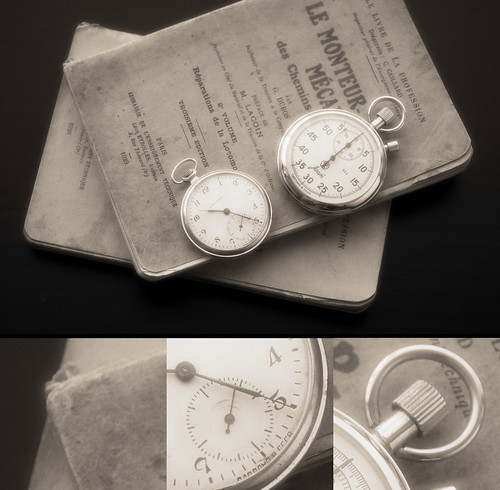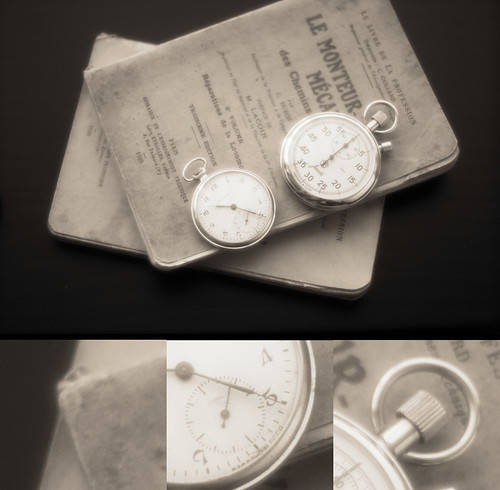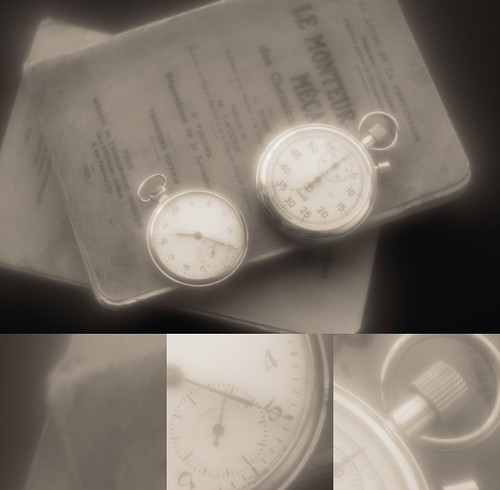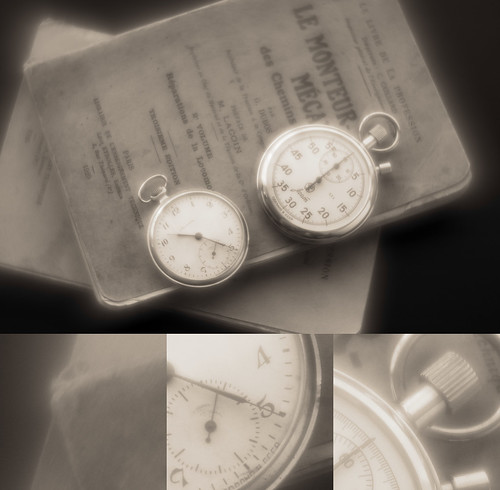I have a copy of Taschen's "Camera Work - The Complete Photographs." It's a weighty, densely filled book given it's rather small size. I often refer to it seeking inspiration and understanding of how Pictorialist/Secessionist photographers worked their art and craft.
There is a copy of "Clarence H. White and his world" on the bookshelf, too. This is bigger and heavier than "Camera Work." It's more of a show catalogue from a curated exhibition. The book comes with long essays that explain White's background, history, life, and times. It's fascinating, actually. It recalls how early practitioners would gather to share ideas, processes, and how they would many times work in groups when making images. It sounds as if it was a very sociable exercise.
One of the many tools Pictorialists might use were soft focus lenses. Some of the works that still impress me the most are by Clarence White, Edward Steichen, Robert Demachy, Karl Struss, and George H. Seeley. One image in particular stands out for me. It was made by George Bernard Shaw of Alvin Langdon Coburn.
For years I've tried to find a process, a technique, an approach to creating soft focus-effect images in the Pictorialist style. Forty years ago I started buying and trying various soft focus lenses such as Wollensak Verito, Portland Portrait, Rodenstock Imagon, Fuji large format SF, and medium format RB 150mm SF lenses
As I started downsizing image capture formats I entered a two decade long "phase" of collecting and shooting with old manual focus Nikon Nikkor lenses. I was looking to take advantage of their more subtle under-corrected spherical aberration behind the point of focus.
Other than a series of images I made using a Mamiya RZ and the RB 150mm SF, the whole exploration of the soft focus Pictorialist inspired effect was nothing but a long series of failures. Out of frustration nearly every soft focus lens I ever owned was sold. Recently I've off-loaded almost all of my Nikon Nikkor lenses, too. Nothing seemed to be "working."
There is only one Soft Focus lens left in the Toy, er, sorry, Tool Box. It is the supremely irritatingly difficult to understand Pentax 85mm f/2.2 lens. I'd picked it up from someone in Japan off That Auction Site. It's uniqueness is that it has a cleanly and correctly installed Nikon F mount in place of the original Pentax K. I didn't need to buy Yet Another adapter for my Sony mirrorless cameras as I was knee deep in Nikkors at the time.
For several years I've been having a conversation with someone about how to correctly use Soft Focus lenses. His first hand knowledge and historic research are second to none. He shares valuable information that I doubt I could've gotten any other way.
Then, two weeks ago, a different photographer provided a partial translation of a Japanese instruction manual on the Pentax 85mm f/2.2 Soft lens. It was clear that I've never used meniscus style soft focus lenses in the way they were designed for.
Like a scab that just can't be ignored, I decided to pick at the subject one more time. Armed with better knowledge, I wanted this time to compare a sharp image to filtered softeners and, of course, to the Pentax 85mm Soft.
One important thing to note before I start. The following comparison uses a subject photographed at very close range. The watches and books were 1 to 2 feet away from the camera. I will cover why this is important in the near future.
Suffice it to say for the moment, these comparison results apply best to close focused subjects.
Setup ~
- Camera -
- Sony A7, 100ISO, 2sec timer, "A" mode
- Lenses -
- Nikon Micro-Nikkor 55mm f/3.5 pre-Ai
- Straight sharp image
- Nikkor #1 soft filter
- Nikon Nikkor-S 50mm f/1.4 pre-Ai
- Straight shot wide open
- Nikkor#1 soft filter
- UV filter very lightly smeared with nose grease
- Pentax 85mm f/2.2 Soft at f/2.2, f/2.8, f/4, and f/5.6
- Bogen tripod
- RawTherapee - similar image processing settings applied to all images
Comparison ~
As always, click on the image and enlarge to 100percent to see whatever there is to be seen.
Nikon Micro-Nikkor 55mm f/3.5 at f/3.5
The old Micro-Nikkor 55mm f/3.5 is one of those great lenses that I've had the pleasure of owning for many years. It's sharp from wide open.
I will use this image as the baseline from which I'll judge the softening effects of filters and optics.
Nikon Micro-Nikkor 55mm f/3.5 at f/3.5 with Nikkor Soft #1 filter
I can see the effect of the Nikkor Soft #1 filter quite easily. The effect is pronounced. Overall there is a lessening of contrast. Highlights can be made to glow. Underlying image sharpness is retained, which can seen under the veiling glow.
I find this effect a little too strong for my liking. Perhaps a surprisingly costly Cinebloom filter would give a more pleasing effect? Optionally I could take a UV filter and make a DIY Cinebloom filter from hairspray mist or a clear coat aerosol of some kind. It would be easy and might provide an effect similar to Cinebloom, and weaker effect to the Nikkor Soft #1. There are YouTube videos that illustrate the making and use of these filters.
Nikon Nikkor-S 50mm f/1.4 pre-Ai at f/1.4
The Nikkor-S 50mm f/1.4 lens is the early and now classic Nikon SLR high speed standard lens. Stopped down, this old lens is modern optics level sharp. So wide open is where I went looking for Pictorialist effects.
At f/1.4 it delivers a certain level of under-corrected spherical aberration behind the point of focus when shot wide-open. I can see some of this in the above image.
However I'm not sure the effect is not strong enough to approach the Pictorialist effect I am looking for. I'm thinking that something more "extreme" is what's really called for.
Nikon Nikkor-S 50mm f/1.4 pre-Ai at f/1.4 with Nikkor Soft #1 filter
As with the Micro-Nikkor I can see the underlying sharpness of the bare lens. It's hidden just under the veiling glow that the filter creates.
Again, I find the effect a little too strong. Additionally, because the basic lens returns a geometrically correct image, the creative "spark" provided in soft focus Pictorialist images is still missing.
Nikon Nikkor-S 50mm f/1.4 pre-Ai at f/1.4 with nose-greased UV filter
In my attempt to emulate Cinebloom and DIY hairspray filters, I took an old UV filter, and using a finger rubbed the side of my nose, spread it very lightly over the filter. I used minimal nose grease to make sure the effect was less than the Nikkor Soft #1.
I can see the effect of the nose grease on the image. It lessens the contrast, but keeps the underlying sense of sharpness.
Nose greased (or hairsprayed) filters combined with the 50mm Nikkor-S shot wide open as an imaging softening combination might actualy be a decent jump-off point for exploring Pictorialist effects. It's a fairly close approximation to the way David Hamilton created his hairspray filter softened images back in the day.
The effect can be
gorgeous. I'll set this aside for a moment and will come back to it in a future post.
Pentax 85mm f/2.2 Soft at f/2.2
Holy Soft Glowy Smokes! this lens is filled with under-corrected spherical aberration wide open. Using the image processing recipe that was used in prior images gives an image that glows so brightly that I need sunglasses.
Under the veil of Holy Soft Glowy Smoke I can see the lens is actually surprisingly sharp. Soft Focus might not mean a complete lack of sharpness. There's a hint of something in this that I'll explore later.
If this was all I had, I'd say this image was simply too soft as to be usable on anything but strong abstracts. It doesn't feel suitable at this aperture for recreating soft focus Pictorialist effects.
Pentax 85mm f/2.2 Soft at f/2.8
I can see the image starting to clear just a bit over the image that was shot wide open. The highlights glow. The mid-tones glow, too. Underlying sharpness of the lens is more clearly seen.
Still using the image processing recipe from the earlier images on this f/2.8 photograph yields a fairly pleasing work. I'm not sure I'd finish the image this way if I were trying to do something "serious," but for the purposes of this comparison the results are beginning to look promising.
Pentax 85mm f/2.2 Soft at f/4
At f/4 I begin to see some kind of "resolution hole" opening from the center of the image. The sharp region of the photograph has more contrast than the edges and the transition is rather obvious. This is where the highlights appear to "pull" away from the center of the image.
With the subject I choose I'm not sure the center being sharp and the edges being soft suit it very well. There may be, however, subjects and compositions where this effect would "work" better than it does here.
Pentax 85mm f/2.2 Soft at f/5.6
The "resolution hole" effect I started to see at f/4 comes into full play here at f/5.6.
I don't think the transition from sharp to soft effect suits this subject well at all. It's hard on my eyes and just doesn't "look" right.
This comparison lays the foundation for the next three blog entries. Onward.









2 comments:
Thank you for taking us on this quixotic journey! You're absolutely right that the behavior of soft focus lenses changes dramatically as the format shrinks or grows. In fact, even a 14-inch Verito used on 8x10 differs radically from a 7-inch Verito on 4x5, even though one might expect them to be comparable.
When conducting these tests, you might consider trying a more mid-distance subject — or even a landscape — in order to gauge whether or not you are achieving a true Pictorialist effect. Some soft-focus lenses like the LensBaby Velvet, designed for 35mm format, work nicely in macro situations (close-ups of flowers) but start looking strangely manipulated once the focus is extended. The physics of all this is beyond me, except to note that lenses with long focal lengths tend to have dramatically reduced depth of field, and therefore probably yield proportionally increased aberrational effects.
Please continue! You've inspired me to go in the opposite direction... larger, rather than smaller. Together, at some point we'll probably conclude that the Pictorialists' preferred format (something like 5x7?) was the sweet spot all along!
Thank you, D.A.W. Stay tuned (as they used to say on the TV).
I'm about to take what I feel are three significant learning steps. The first significant step after this close-up comparison will indeed be to show the behavior at mid-distance. Then I will take a short non-optical side-step and look at the impact of image processing on this whole Soft Focus Lens Madness. There were for me a few surprises here. Then I will wrap the series up by looking at this Dastardly Difficult Lens in landscape situations. There, too, lay an interesting surprise or two.
Thanks for having a look. Your thoughts and comments are helpful.
Post a Comment